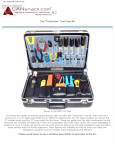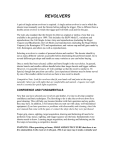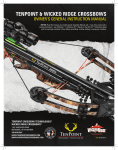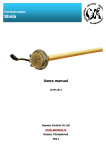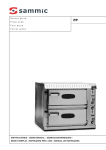Download H&K P9S User Manual
Transcript
P9S AUTOMATIC PISTOL Caliber .45 ACP P9S Automatic Pistol Caliber .45 ACP Instruction Manual HECKLER & KOCH, INC. 2148 Pacific Boulevard Sterling, Virginia 20166-8903 U.S.A. TEL. (703) 450-1900 TELEFAX (703) 450-8160 TELEX 7109550846 Heckler & Koch, Inc. U.S.A. WARNING: READ ALL INSTRUCTIONS BEFORE HANDLING & USING THIS FIREARM. Safety Rules PLEASE READ THIS BEFORE HANDLING YOUR FIREARM. The following safety rules are placed in this manual by Heckler & Koch, Inc. as an important reminder that firearms safety is your responsibility. Firearms can be dangerous and can potentially cause serious injury, damage to property or death, if handled improperly 1. Never point a firearm at anyone, or in any direction other than a safe one, i.e., downrange 2. Always treat all firearms as if they were loaded. 3. Keep your finger off the trigger until your sights are on the target. 4. Keep your finger off the trigger while loading or unloading the pistol. 5. Keep your finger off the trigger while pulling pistol out of the holster or holstering. 6. Be sure of your target and the back stop beyond. 7. Never give to or take a firearm from anyone unless the action is open. 8. Be sure that the ammunition you are using is factory loaded and is not damaged in anyway. 9. Before firing, remove the magazine from the weapon, lock the bolt to the rear and check the barrel of your unloaded firearm for any possible obstructions. 10. Before firing any firearm unfamiliar to you, make sure that you understand how it functions. Unfamiliarity can cause serious accidents. Attend a certified training course on any firearm which you intend to use or with which you are not sufficiently familiar. 11. Wear hearing protection and eye protection when shooting your firearm. 12. Keep your hands and fingers away from the muzzle to avoid injury or burns. 13. Firearms and ammunition should be stored separately beyond the reach of children and untrained or irresponsible adults. 14. Avoid the use of alcoholic beverages before and during any shooting. REMEMBER: A FIREARM HAS THE CAPABILITY OF TAKING YOUR LIFE OR THE LIFE OF SOMEONE ELSE! BE CAREFUL WITH YOUR FIREARM – AN ACCIDENT IS ALMOST ALWAYS THE RESULTS OF NOT FOLLOWING BASIC SAFETY RULES. This page left blank intentionally… TABLE OF CONTENTS NOTES: 19 of 19 Characteristics……………………………………………………............... 1 Handling the P9S Automatic Pistol………………………………………. 2 Safety……………………………………………………………………….. 2 Filling the Magazine……………………………………………………….. 3 Loading and Cocking the Pistol…………………………………………... 4 Unloading and Uncocking the Pistol……………………………………... 6 Firing………………………………………………………………………… 7 Field Stripping for Cleaning…………………………….…………………. 7 Assembling the Pistol……………………………………………………… 9 Care of the Pistol…………………………………………………………… 10 Assemblies………………………………………………………………….. 11 Special Accessories………………………………….…………………….. 11 Specifications……………………………………………………………….. 14 Components of the P9S Automatic Pistol……………………………….. 15 HECKLER & KOCH GmbH in Oberndorf/Neckar has a long tradition and vast experience in the development and manufacture of automatic small arms. NOTES: In particular the well proven Automatic Rifle G3, standard weapon of the Federal German Army and the armed forces of numerous NATO countries as well as the HK Weapons System which was developed from it, are manufactured of quality materials in accordance with the noncutting method, the most economic and advanced method in modern weapons technology. And, of course, this also applies to the P9S Automatic Pistol Characteristics The P9S Automatic Pistol with double action trigger has a concealed hammer and lateral cocking lever with uncocking safety. This highperformance automatic pistol is characterized by the polygon groove shape of its stationary barrel and its recoil-operated roller-locked bolt system. This locking system has met with particular interest in modern weapons technology. By breaking down the momentum in the bolt, the recoil velocity of the slide is significantly reduced, and with it the perceptible kick. Gas cutting is largely eliminated because there are no pronounced grooved and lands in the polygon barrel, resulting in increased projectile velocity and notching resistance, and making it easy to clean. In conjunction with the short distance between the upper edge of the shooter’s hand and the axis of the barrel, the above characteristics ensure that this pistol is extremely accurate and line up fast. We were one of the first to recognize the excellent suitability of plastic material for certain parts of our weapons and equipment. The high resistance of the new plastics to extreme temperature variations has proven to be of exceptional value, such as on the grips of military arms for example. For this reason, the receiver of the P9S is covered completely with plastic. 1 of 19 18 of 19 Handling the P9S Automatic Pistol NOTES: Safety The safety can be engaged or disengaged by switching the safety lever. If the red mark is visible the safety is off. Fig. 1: Safety off If the white mark is visible the safety is on. Fig. 2: Safety on 17 of 19 2 of 19 Filling the Magazine Insert the cartridge under the magazine lips, base first, by pressing down follower or the cartridge. The magazine holds 7 cartridges. Fig. 3: Filling the magazine 3 of 19 16 of 19 Components of the P9S Automatic Pistol Cal .45 ACP 1 2 3 4 5 6 7 8 9 10 11 12 13 14 19 20 21 22 23 24 25 26 27 28 29 30 31 32 33 34 35 36 37 38 39 40 41 42 43 Front sight Slide Rear sight Safety Recoil spring Barrel Extractor Locking rollers Compression spring Pressure pin Compression spring for pressure pin Locking catch Clamping sleeve Compression spring Firing pin spring Firing pin Spiral pin Bolt head Threaded pin Compression spring Catch bolt Cylindrical pin Bolt head carrier Support Sleeve Raised countersunk head screw Buffer housing Plastic buffer Stop pin 44 45 46 47 48 49 50 51 52 53 54 Disconnector Cylindrical pin Pull bar Trigger lever Spring for pull bar Indicator pin Spiral pin Hammer Stop pin Spring for disconnector Axle for hammer 55 56 57 58 59 60 61 62 63 64 65 66 67 68 69 70 71 72 Barrel catch Insert piece Trigger spring Trigger Compression spring Catch bolt Elbow spring 73 74 75 76 77 78 79 80 81 Threaded bush Raised countersunk head screw Trigger guard Receiver Safety catch Elbow spring Cocking lever Catch Countersunk screw Bearing plate, left Angle lever Intermediate lever Bearing plate, right Shank Compression spring Magazine catch Combat grip *Raised head countersunk screw Magazine housing Follower Follower spring Support for follower spring Magazine floor plate Ejector Ejector spring Pin for magazine catch Flanged bush Catch lever Spring for catch Loading and Cocking the Pistol Only with the safety on! First method Insert a filled magazine into the closed weapon until the magazine catch engages. Pull back slide all the way and let it snap forward. This chambers the top cartridge from the magazine (Fig. 4). Second method Pull back slide all the way and press the cocking lever upward until the catch engages the notch. Now insert a filled magazine into the open weapon. Either: Pull slide back and release. Or: Press cocking lever downward. In both cases the slide will snap forward and chamber the top cartridge from the magazine. Fig. 4: Pull back slide With both methods the pistol is then loaded, the hammer is cocked and the safety is on. The indicator pin (Fig. 5) which can be both seen and felt at the rear of the slide shows that the hammer is cocked. The protruding extractor (Fig. 6) lets the shooter both see and feel that a round is in the chamber. *Use short screw in topmost hole of grip 15 of 19 4 of 19 Technical Data P9S Automatic Pistol Fig. 5: Indicator pin Fig. 6: Extractor Reloading when the magazine is empty After the last round has been fired, the slide will remain in its rearmost position. To continue firing immediately, simply exchange the empty magazine for a full one and Operating principle…………………………….. Action……………………………………………. Feed……………………………………………... Caliber…………………………………………… Recoil operated Roller locking system 7 round straight magazine .45 ACP Muzzle velocity –Vo-…………………………… Muzzle energy –Eo-…………………………… approx 840 fps approx 370 ft lbs Length of pistol…………………………………. Height of pistol…………………………………. Width of pistol over grips……………………… Length of barrel………………………………… Sight radius…………………………………….. 7.6 in 5.4 in 1.3 in 4.0 in 5.8 in Weights Pistol, without magazine………………………. Magazine, filled with 7 cartridges…………….. approx. 27.85 oz approx. 7.78 oz Either: Press the cocking lever downward, causing the slide to snap forward. Or: Pull the slide back slightly and let it snap forward. The pistol is again ready to fire. Fig. 7: Reloading the pistol 5 of 19 14 of 19 Unloading the Pistol Engage the safety! Remove the magazine (Fig. 8). Pull the slide back all the way; cartridge will be ejected. Check to make sure that there is no round in the chamber. Permit the slide to snap forward again. Fig. 17: Adjusting the elevation Adjusting the windage Rotate the windage adjusting screw in the desired direction with the screwdriver (Fig. 18): Rotating clockwise moves the shot to the left Rotating counter-clockwise moves the shot to the right Each click shifts the point of impact approx. 0.4” to the left or the right at a range of 27.3 yds. Fig. 8: Press back magazine catch Uncocking the Pistol In loaded or unloaded condition. Engage the safety, press down the cocking lever, pull trigger all the way back, permit cocking lever to return slowly upward again, release trigger. Should your thumb accidentally slip off the cocking lever, the hammer is caught by the uncocking safety. If the trigger is accidentally pulled, with the safety on, before the cocking lever is depressed, the safety catch will then prevent the hammer from striking the firing pin. Dry firing only with safety off. If the pistol is to be carried ready to fire, disengage the safety again. Fig. 18: Adjusting the windage 13 of 19 6 of 19 The hammer must now not disengage. If it does, it is set too finely and the screw must be backed off further. If set too finely, the pistol could double; if this is the case, turn back the fine adjustment screw even further. Firing Firing with the hammer cocked Pistol loaded (cartridge in the chamber). Disengage the safety. Pull the trigger; this will release the cocked hammer. Light trigger pull = increased accuracy. It is not possible to regulate the trigger pull. Firing with the hammer uncocked and double action trigger Pistol loaded (cartridge in the chamber). Disengage the safety. Pull the trigger; the hammer will cock until it is released. The relatively light double action trigger permits the hammer to be cocked for the first shot or to be re-cocked in the event of a misfire. The double action trigger results in longer trigger travel and increased trigger pull. Rotating clockwise reduces the engagement of the catch lever in the hammer, rotating counter-clockwise increases it. Field Stripping for Cleaning Engage the safety! Remove the magazine. Pull slide back all the way and check to make sure that there is no round in the chamber. Permit the slide to snap forward again. Press the barrel clamp in the trigger guard forward and upward. Move the slide as far forward as it will go and lift off. (Fig. 9) Fig. 16 Regulating the fine adjustment device Click sight To provide the target shooter with individual sights, a click sight, adjustable for elevation and windage with 8 clicks per revolution was developed by H&K. Adjusting the elevation Rotate the elevation adjusting screw in the desired direction with the screwdriver (Fig. 17): Rotating clockwise lowers the point of impact approx. 0.6” per click at a range of 27.3 yds, rotating counter-clockwise raises it accordingly. Fig. 9 Remove slide. 7 of 19 12 of 19 Assemblies (Fig. 14) To remove the barrel, push it forward against the pressure of the spring until it can be removed from the slide. 1 Slide 2 Barrel with recoil spring 3 Receiver 4 Magazine Special Accessories Trigger stop The trigger stop for the P9S Automatic Pistol is located in the trigger guard on the receiver and limits the trigger travel immediately after the hammer has been released; it simultaneously interrupts actuation of the double action trigger. The trigger stop must be swiveled away for firing with the double action trigger. It can be loosened or clamped by means of the screw (Fig. 15) and can be set as desired. (Must be performed after setting the fine adjustment feature.) Fig. 10 Remove the barrel Fig. 11 Press against the locking catch. To remove the bolt head, with one shank end of the barrel extension between bolt head and slide, press against the locking catch until both head springs forward and the bolt can be removed. Fig. 15 P9S with trigger stop Fine adjustment feature A fine adjustment device can be installed in the receiver for increased trigger travel precision. The setting operation is best performed as follows: Fig. 11 Press against the locking catch. Remove the slide and cock the hammer. Rotate the setting screw clockwise until the hammer snaps. Now back off the screw one half turn. Replace slide, pull back all the way and let it snap forward again. 11 of 19 8 of 19 Assembling the Pistol Care of the Pistol Caution: Safety required that both rollers be in place in the bolt head when assembling the weapon. For cleaning, the pistol must merely be field-stripped as described on pages 7 & 8. To insert the bolt head, place its rectangular opening on the locking piece (extractor towards the ejection port) and, as when removing, press the locking lever downward with one shank of the barrel extension and pull the bolt head back again until it engages. The service life and the performance of your pistol depend upon correct handling and proper, regular cleaning. Push the barrel, with the recoil spring (wider end of spring facing forward), obliquely into the hole in the slide against the pressure of the spring (Fig. 12), then place the barrel entirely into the slide and permit to travel back until the locking rollers engage. The barrel must be cleaning after every shooting. Generally, cleaning consists of removing dirt and moisture. Bright parts must be wiped clean and lubricated lightly with oil. Any commercial chlorine and acid-free solvent, gun oil or gun grease can be used. It is best to grease the slide guide only lightly. Fig. 12 Insert barrel Place the slide on the receiver in such a manner that the front guide lugs can engage the corresponding recesses in the receiver. Press the slide into the receiver, pull back and let it snap forward again (Fig. 13). Uncock the pistol and insert magazine. Fig. 13 Place slide on receiver Fig. 14 Assemblies 9 of 19 10 of 19













